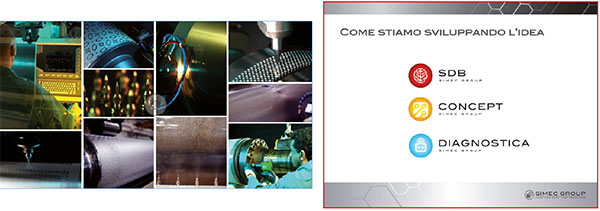Scenarios and technologies for flexible packaging
Packaging is an ever increasingly complex and fascinating topic. Forget about the past and try to imagine a holistic approach to a “medium” that has the objective of instigating an emotional interaction with consumers, integrating extra functionalities, new elements of communication/interactivity and benefits other than the primary ones. All of course without neglecting to produce and print the packaging always in the best possible way and at competitive costs… Stefano Lavorini
Producers of printers, rolls and inks, but also converters and end users contributed as speakers to the conference, which took place in Milan last 27 March, playing their parts with distinction, supplying helpful indications on the technological development of flexible packaging printing - in some cases by undoing longstanding beliefs and conventional wisdom - and on the evolution of this packaging type.
It couldn’t have been otherwise, considering the fact that the event, promoted by Windmöller & Hölscher Italiana in collaboration with Rossini, Simec Group and Sun Chemical Group Italia, also featured testimony by Fiorini International, Di Mauro and Unilever.
In general, the talks were extensive and well-coordinated. The only downside is that the occasion deserved a much larger audience.
But let’s “not” do things in order…
The last one wraps up the game… And so, for once, let’s start with the last presentation of the day, that of Massimo Rosati, a Unilever manager in charge of innovation in the detergency sector.
His words echoed this publication’s presentation of Ethical Packaging Paper, which has been published for the occasion of Ipack-Ima 2015, on 19 May: “Packaging, being an essential and contradictory object, is going through a stage of full maturity, and as such, imposes a shared journey of reflection. While on one hand the “counter-narratives” in recent years have shed particular light on critical points, on the other it is impossible to avoid a general re-thinking in order to make packaging evolve along with the needs of the consumer, user, environment and society”.
Indeed, with great clarity and lucidity Rosati delineated the strategies of the multinational, which focus on business growth, while at the same time reducing the concern’s environmental footprint and enhancing its social impact.
The point of departure in this process of renewal and innovation are global trends:
- the digital revolution, which opens new channels and opportunities for interacting with consumers, and which thus also steers the development of packaging in a context in which the shelf is no longer the only instance of contact with the end user;
- new lifestyles, marked by processes of urbanization and migration that presuppose the need for developing products bearing the seal of a multicultural society;
- attention to the environment which, while still not one of the main drivers of growth and consumption, is becoming an important element of concern and distinction for consumers on a global scale;
- finally, signs that markets are moving East and South, with an impact on strategies for producing and stocking raw materials.
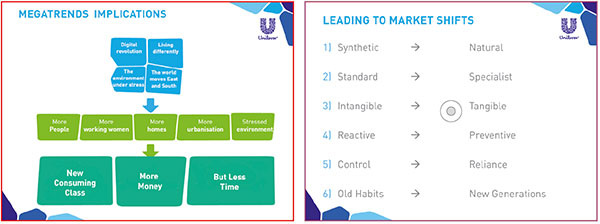
With these social and demographic phenomena in mind, Rosati explained, Unilever has defined its guidelines for the development of packaging. He then carefully illustrated the implications of the major trends and the changing approaches of consumers toward products.
The outcome of this journey of ideas is a packaging which, for Unilever, has the mission of guaranteeing the “basic”, non-negotiable functions, namely protection and communication; but with an added focus on creating new modes of interaction with consumers, with the help of more emotively charged elements, including additional functions, new elements of communication/interactivity, and benefits other than the primary ones.
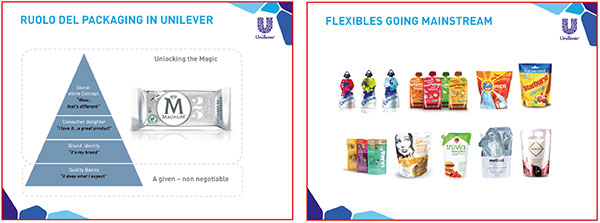
What’s more, on this point, flexible packaging is also growing in importance in previously marginal outlet sectors, such as non-food, where it is used mainly for refills.
More generally, there is a trend, demonstrated by the most recent applications on the market, to tackle the weaknesses of this packaging type, particularly as far as concerns handling, dosability and reclosability, including by creating hybrid structures that integrate elements of flexibility and rigidity, with the objective of guaranteeing consumers new advantages and new opportunities.
«There is a need to develop innovative products based on circular thinking… Unilever is adopting a holistic approach in order to find a balance between conventional practice, in which the end user defines the packaging’s characteristics, and the need to clearly capture the needs of consumers, all with the help of an integrated and cohesive value chain. Today, for Unilever it is fundamental to correctly interpret the product concept and packaging materials in order to facilitate recycling and re-use.
And in this area there is still much to do».
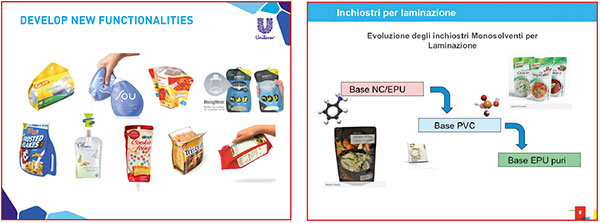
He who spends, spends less… Now to resume the normal course of the event, Enrico Vogogna of W&H gave the opening talk: after presenting the German concern, which builds, among other things, flexographic and rotogravure printers, he sketched an outline of the flexible packaging market in the various regions of the world and its growth dynamics, including in comparison to other materials. «A difficult market, but one that offers enormous opportunities, insomuch as flexible packaging, according to forecasts, should double in the next 20 years». Vogogna then gave a close analysis of the various costs entailed by printing, with an emphasis on the fact that the capacity to generate income - net, factoring in raw materials - is built on timeframes, production efficiency and wastage volumes, or in other words, on selecting the most economically advantageous machine.
Special interactions: inks and adhesives… Egidio Scotini (Sun Chemical Group) introduced the topic of water-based inks for lamination and, more generally, of the advantages of solventless solutions: a technology by now no longer to be considered experimental, at least with flexographic printing, and one capable of guaranteeing neatness, yield, simplicity, low cost and, above all, safety.
Water-based lamination inks are formulated starting with basic ingredients currently used for printing on paper and board, but with a different high tech varnish, in such a way as to guarantee adhesion to the most commonly used films. Their compatibility has also been tested with the majority of solventless adhesives, with excellent results. In a word, then, water-based inks enable having final bond values at delamination in line with those of materials printed and laminated using solvents, they have the same color strength and a complete color index range, and they are FDA approved. They also have the important advantage of no solvent retention.
As for rotogravure printing, Scotini went on to discuss mono-solvents for lamination, dedicating particular attention to the interaction between ink and adhesive in high barrier structures, including those which undergo heat processes. In fact, Sun Chemical, by reaping the fruits of the competencies and experiences of its Japanese parent company DIC Corporation in the production of lamination adhesives, has developed a range of low migration pure polyurethane-based inks with extremely high performance (no nitrocellulose, chlorine or monomeric plasticizers) which solves the problem of dissolving inks and the formation of air bubbles in the laminate, as well as solvent retention.
Put simply, ink and adhesive must be as compatible with each other as possible, and thus, all the better if they come from the same supplier.
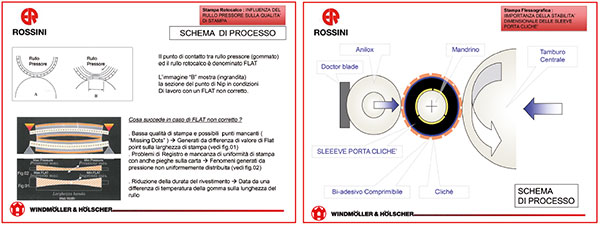
How relations with the market change… Laura Della Torrre spoke about the evolution of anilox rolls in relation to the needs of flexo printing. The representative of Simec Group illustrated the project which, establishing a relationship of transparency and cooperation, is set to change the way this product is sold: new tools (advanced CRM, for example) for sharing documents and data, and new services with the objective of guaranteeing customers correct configuration of the anilox rolls, according to the machine used and the print to be performed, consistent product quality, but also correct maintenance. All told, Simec is implementing an idea of partnership that seeks, through constant monitoring of the rolls, to help customers manage any problems relating to the machinery, reduce format changeovers and contain costs.
At the core, quality… Dimensional stability of the plate cylinders, above all else… This point was made emphatically by Angelo Alloggia of Rossini, because otherwise the print results would be disastrous, all the more with latest generation flexo machines that can reach 1,100 m/minute. After having illustrated the daunting task of plate cylinders (uniform transmission of the print pressure throughout the length of the plate, minimal eccentricity, easy application and removal of the double-sided tape, chemical and mechanical resistance), the speaker presented a top of range solution developed by Rossini: the Starcoat sleeve. Its structure in polyurethane, a material that is unstable over time on its own, is completely encapsulated in fiberglass. Moreover, these sleeves are equipped with a protection ring (register slot protection flange), made out of elastic polyurethane to prevent deformations.
The concern dedicates the highest care to rolls in the rotogravure field as well; impression rolls in this case, as Alloggia pointed out, which must be designed and built in order to guarantee a maximum deviation of 0.1 mm/m, and with a coat with 50% rebound (characteristics of Rossini products). But caution is a must: in order to achieve excellent quality and uniform printing, it is necessary to accurately adjust the pressure at the point of contact between the rubberized roll and the printing roll. The hardness of the impression roll must also be adjusted according to the material to be printed, a point which often goes ignored. In the case of machines with formats between 1,000 and 4,000 mm, or more, and pressures exceeding 6 kg/cm, Rossini has created special steel rolls that integrate the rubberized coating’s convexity.
The right flexo solution, tailored and automated... Clear and calm words were offered by Marcus Bauschulte who, facts and figures in hand, presented the historic trend and others relating to flexo printers, according to W&H. And not without a surprise or two… In fact, the last five years have seen a trend reversal on the part of converters which, faced with the growing and “unstoppable” fragmentation of orders, have progressively oriented themselves toward dedicated machinery.
In other words, growth has been most positive for concerns that opt for machines with “just” 8 colors, speeds lower than 400 m/minute and a maximum web of 1,000 mm, such as the Miraflex S, a compact system that enables reducing setup times thanks to a high level of automation, which facilitates setup of register and color, as well as washing.
While, indeed, the flexible packaging market is growing, as much can be said of competition among converters, and the choice of machine becomes decisive, especially considering that, in many cases, 85% of production costs derive from raw materials, and the fact that the real competition is over reducing setup and printing times, as well as wastage.
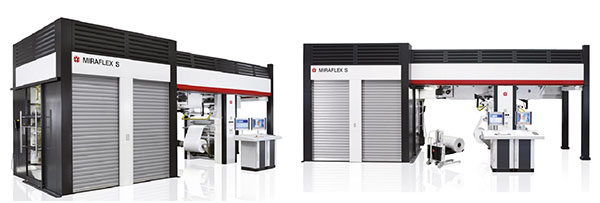
Happy and innovative… The choice of testimonials was impeccable. Luigi Fiorini supplied a snapshot of Fiorini International, which in less than twenty years has become a global player in the field of shopper bags. Today, with 400 employees and a turnover of 100 million euro, 65% of which generated abroad in 70 countries, the concern is carefully planning the passing of the torch to the second generation. Fiorini himself went through the history of the concern, recalling how important the choice of its first “quality” printer (a W&H 8 color) and the part it played in the business’s future development.
The capacity for innovating on the basis of market cues is a trait also shared by Di Mauro. Specialized in printing and laminating medium-high barrier structures, this concern, based in Cava dei Tirreni has invested in a new facility equipped with a W&H 11 color Heliostar SL rotary machine capable of printing both film and aluminium, as well as duplex and triplex laminators and a line for extrusion coating and extrusion lamination.
The production area is equipped with a roll engraving division, a warehouse for 14 thousand print matrices and installations for solvent recovery and cogeneration.
This is all state of the art equipment, as Velleda Virno emphasized, which enables achieving special print effects and product innovation, namely enhancing the performance of flexible packaging at a reasonable price, not to mention easy to implement on packaging lines.
A few examples developed by the R&D team: Reclosable Twist Pack, which takes advantage of aluminium’s fold memory properties; Tearing Strip with easy open and a tear-away strip obtained from the laminate itself; and Drip Pack with a drip valve for expelling preserving liquid before opening.
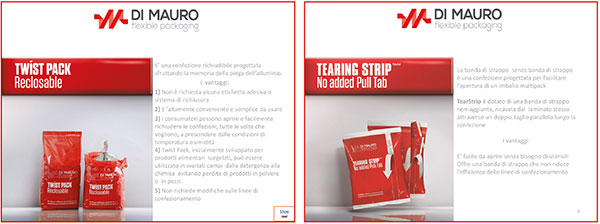
The production area is equipped with a roll engraving division, a warehouse for 14 thousand print matrices and installations for solvent recovery and cogeneration.
This is all state of the art equipment, as Velleda Virno emphasized, which enables achieving special print effects and product innovation, namely enhancing the performance of flexible packaging at a reasonable price, not to mention easy to implement on packaging lines.
A few examples developed by the R&D team: Reclosable Twist Pack, which takes advantage of aluminium’s fold memory properties; Tearing Strip with easy open and a tear-away strip obtained from the laminate itself; and Drip Pack with a drip valve for expelling preserving liquid before opening.

A rotary machine that accelerates profits… In the converting business it’s possible to get earnings out of smarter use of the machine, and/or by increasing printing speeds.
Emilio Alliegro of W&H explained how.
As for the first point, in order to make operators’ jobs easier, the German concern has integrated all auxiliary equipment (viscosimeters, corona treatment, register control, etc.) into the rotary machines, so as to have just one recipe memorized and speed up format changeovers.
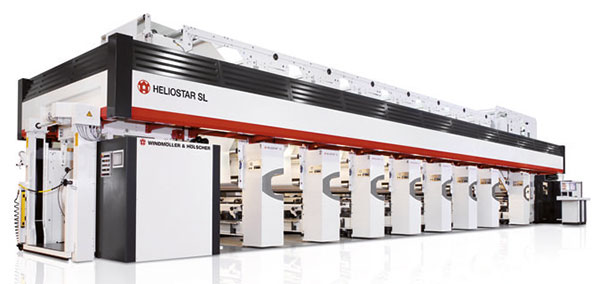
The same goal was reached by simplifying the doctor knife changeover process, both manual and automatic, as well as that of the impression roll, along with disassembly and cleaning of the blowers.
Format changeover speeds are evidently a focal point, and to this end W&H proposes a new highly effective automatic washing system that uses the turbulence of the print roll, paired with automatic changeover of rolls with or without pivot, which requires manual positioning of the carriage by the operator: both operations are performed simultaneously on all elements of the machine.
Then there is the system for setting pre-register without marks, which enables significant saving on materials.
Finally, as for enhancing print speed, the solution lies with the new W&H machines: in addition to a vibration reducing frame, they feature specially designed characteristics, such as the inking roll positioned at 3 o’clock (facilitating exchange of the inks contained in the cells), as well as drying elements with air speed adjustment, useful for creating a turbulence effect for drying.



